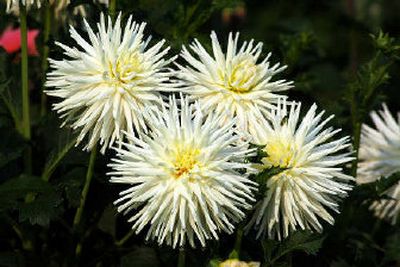Magnificent Manito

One of the best parks and gardens that can be found in the Inland Northwest is in Spokane. Colorful, large, exotic flowering plants and bushes can be found all year. There are 90 acres to explore in season with roses, dahlias, lilacs and a huge variety of annual and perennial plants. There is an indoor greenhouse that can lift your spirits on the coldest, dreariest day. Manito Park on Spokane’s South Hill is a premiere place to visit.
This park is so large that new visitors might miss some of the gardens. Probably the best place to start is at the greenhouse, the Gaiser Conservatory.
Open all year and with free admission, the building has a central dome entrance where large tropical plants are housed. Two greenhouses extend from the central area with more colorful plants, including a variety of cacti. The flower display is changed with the season.
Directly south and in front of the greenhouse is an extensive formal garden with three acres of bedded annual plants with several large stone structures. Designed and built in 1913 by John W. Duncan, this garden is described as having a “classical European Renaissance style with bilateral symmetry and geometrical garden beds.” All that means is that the colorful beds of flowers and grass areas will knock your socks off. There is a large granite fountain in the garden with water play that changes every few minutes.
West of the greenhouse is Rose Hill. If you like the scent and look of roses, this is a must-see walk through. There are 1,500 rose bushes with more than 150 varieties. There are less formal gardens around the perimeter with more roses. Keep looking and you will find that perfect rose bud in your favorite color. The rose garden season will extend until the first frost or the end of October.
Next to the roses is the Inland Empire Dahlia test garden. It is away from the road and requires some walking, but seen from the rose garden the dahlias are very obvious with their tall, colorful, showy blossoms. North and down hill from the greenhouse is a large perennial garden. Here is a good place to find ideas for your own flower beds.
The Nishinomiya Japanese Garden is in the southwest section of Manito Park and is easy to miss. There is a water fall and pond inside the fenced garden. The sound of the water fall, the large golden fish in the reflection pond can provide for a very peaceful setting.
At the entrance to Manito Park are a large children’s playground and a duck pond that was originally called Mirror Lake. A large Spokane park would not be complete without lilacs. The narrow road that winds through the park passes by a lilac garden that brightens up in late spring with purple and white blossoms.
Spokane city voters approved an annual levy for parks in 1907. Even in those days, green areas were a priority in Spokane. Roads, flower gardens, playgrounds, tennis courts, greenhouses and a ball field were built in Manito Park, all completed by 1913. The formal gardens were built that same year. The large granite fountain in the formal garden was a gift of Mrs. L. M. Davenport in memory of her husband, Louis. Besides being owner of a prominent Spokane hotel, Louis Davenport was for years on the city park board.
Manito Park is a gem. Take an afternoon to visit this attraction. Even on a cold winter day this place can warm and raise the spirits. You will enjoy it.